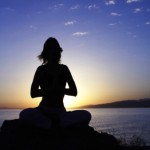 By Faye Martins
By Faye Martins
How can pranayama increase mental clarity? Although many people are only familiar with the physical postures of Yoga, there are also a number of very effective Yogic breathing exercises that can invigorate you or calm you down. Additionally, there are pranayama or breathing exercises that can effectively “clear the mental cobwebs” and help to increase mental clarity. Many Yoga students will benefit from a regular practice of pranayama exercises that increase mental clarity. As your thinking becomes sharper and more focused, you will be better able to complete your academic work in a more efficient and high quality manner.
Bastrika Pranayama is one of the most effective pranayama exercises to increase mental clarity. This practice will also balance your sympathetic and parasympathetic nervous systems, so that you will feel both energized and calm at the end of your pranayama session. You can practice this breathing exercise on a straight back chair or on a pillow on the floor. The full breathing exercise for experienced practitioners takes about twenty minutes, but if you are short on time, a practice of even 5-10 minutes will offer you substantial benefits and increase mental clarity. For beginners, a 1-2 minute introduction at a slow pace is a good start. Bellows Breath (Bastrika) is one of the more dynamic pranayama practices and it is a lot of work for those who are not used to it. So, if you teach beginners, or are just starting out, take it easy and work slowly.
* Preparation for Bastrika Pranayama
Sit comfortably on your chair or meditation cushion with your spine in a relaxed, upright position. Close your eyes and take a few deep breaths. Remember to exhale fully. To begin the preparation exercises for Bastrika Pranayama, breath in fully for a count of eight, retain your breath for a county of eight, and then exhale completely and steadily for a count of eight. If eight counts feels too long for you, you may reduce your count to five or six. The most important aspect of this preparation exercise is to balance the count of your inhale, retention and exhale.
Practice this complete Yogic breath for five rounds with your hands on your hips. Then practice five more rounds with your hands directly in front of your heart area with your palms facing the floor, your fingers touching and your elbows extended to the sides at shoulder height. For the final round of five complete Yogic breaths, place your hands on the back of your shoulder blades with the insides of your upper arms touching your ears. Breathe deeply and fully for five complete breaths while holding this position. This position will open up your lung cavity so that your practice of Bastrika Pranayama will be deeper and fuller.
* Bastrika Pranayama
Now you are ready to practice Bellows Breath or Bastrika Pranayama. This breath is rapid and entails a degree of velocity on your exhale. As you inhale, raise your arms over your head. As you exhale, expel your breath with some forcefulness as you bring your arms back to your side. Repeat this breath thirty to fifty times for three rounds. To finish, sit quietly on your chair or pillow and feel the energy and peacefulness coursing through your entire being. As a result, you will increase mental clarity. You may find is very relaxing and revitalizing to meditate for ten to fifteen minutes directly after your pranayama practice.
© Copyright – Aura Wellness Center – Publications Division
To see our selection of Yoga teacher training courses, please visit the following link.
https://aurawellnesscenter.com/store/
Are you interested in Meditation Teacher Training?
Click here to see our online Yoga Nidra teacher training course.
Are you an experienced teacher looking for YACEP credits or continuing education?
Subscribe to Our Newsletter for Special Discounts and New Products
Related Resources
Amy E. Beddoe, Chin‐Po Paul Yang, Holly Powell Kennedy, Sandra J. Weiss, Kathryn A. Lee, The Effects of Mindfulness‐Based Yoga During Pregnancy on Maternal Psychological and Physical Distress, Journal of Obstetric, Gynecologic, & Neonatal Nursing, 10.1111/j.1552-6909.2009.01023.x, 38, 3, (310-319), (2009).
Kelly B. Smith, Caroline F. Pukall, An evidence‐based review of yoga as a complementary intervention for patients with cancer, Psycho-Oncology, 10.1002/pon.1411, 18, 5, (465-475), (2008).
Lorenzo Cohen, Carla Warneke, Rachel T. Fouladi, M. Alma Rodriguez, Alejandro Chaoul‐Reich, Psychological adjustment and sleep quality in a randomized trial of the effects of a Tibetan yoga intervention in patients with lymphoma, Cancer, 10.1002/cncr.20236, 100, 10, (2253-2260), (2004).
by Leslie Kaminoff and Amy Matthews
52 Essential Principles of Yoga Philosophy to Deepen your Practice
by Rina Jakubowicz.
A Relaxing Way to De-stress, Re-energize, and Find Balance
by: Gail Boorstein Grossman.
YOGA: THE PATH TO HOLISTIC HEALTH
by B.K.S. Iyengar
TEACHING YOGA: Essential Foundations and Techniques
By Mark Stephens

Lovely article on Bhastrika Faye.
I like the preparation exercise here – simple and effective – reminds me of some of the Kundalini pranayams.
Have you any more on any other breathing techniques please? Would love to read them 🙂
With thanks and Namaste,
Matt 🙂
Pranayama or breathing exercises that can effectively “clear the mental cobwebs” and help to increase mental clarity. Nice sharing!
Bastrika Pranayama is one of the most effective pranayama exercises for increasing Mental Clarity and energizing the body. Thanks for sharing this article.